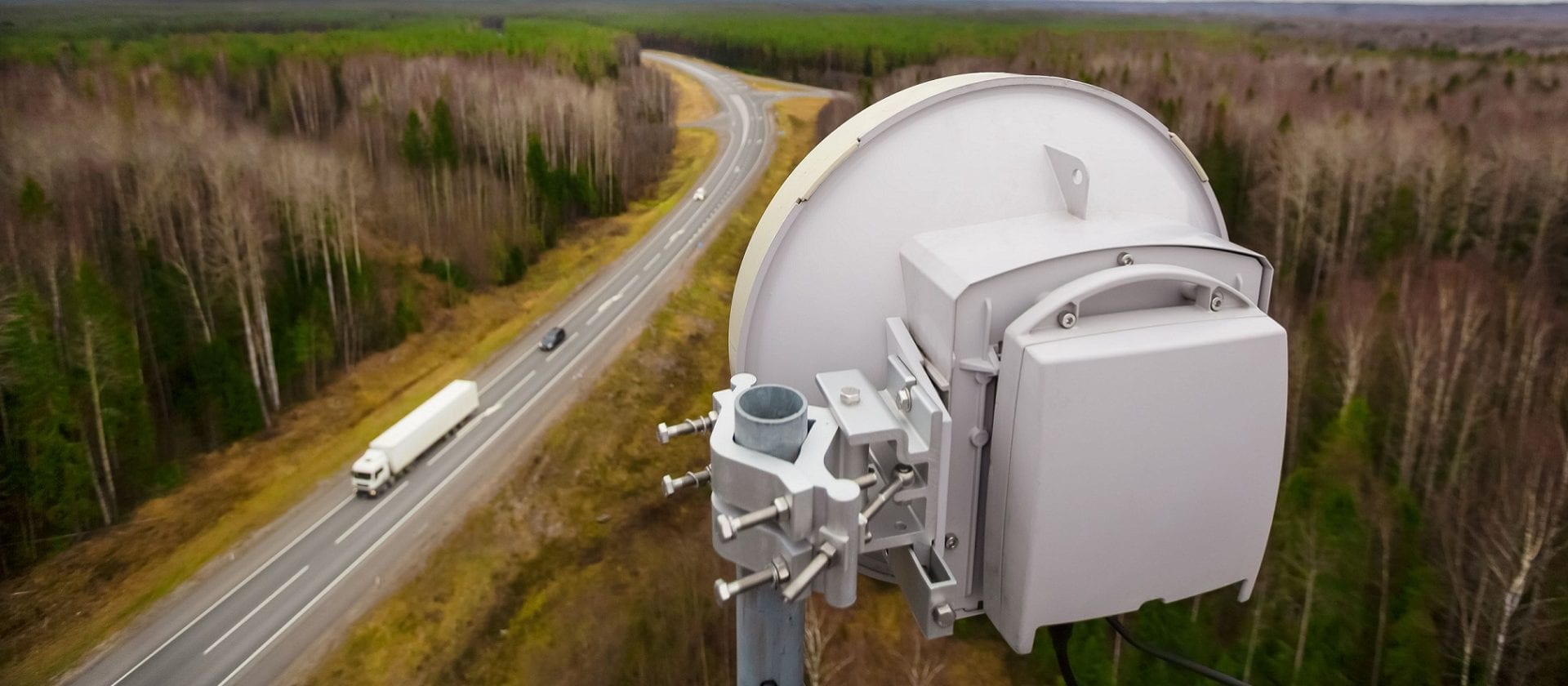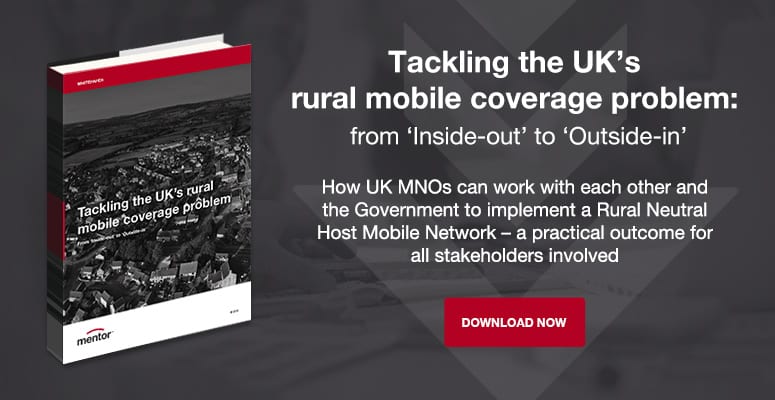How to release the brakes and connect the communities of rural Britain
Solving the rural coverage issue once and for all
People’s lives in rural communities are really blighted by their lack of connectivity.
200,000 homes in this country don’t have a good mobile signal. Hard to believe but that’s nearly half a million of us.
And 41,000 buildings don’t have reasonable broadband service either.
For the last few years, Mentor has been working on cracking the twin challenges of 4G densification and 5G mobilisation in our biggest cities.
Today, we’re applying the lessons learned to tackle the rural mobile coverage problem in the UK and eliminate the Digital Divide.
Rural Britain – living off scraps from their urban cousins
People in rural areas don’t want our sympathy – they just want a decent mobile service. And they’ve waited long enough.
Many of us know that Operator profit in rural areas is as elusive as delighted customers.
Over the years, many previous spectrum auctions have carried with them rollout obligations. Yet, while coverage has improved for some people – it hasn’t for others.
This time around, Ofcom wants to target the rural mobile coverage problem again. The latest spectrum consultations on 700MHz and 3.4-3.8GHz – strongly imply that.
Ofcom says only 66% of the UK’s landmass has good 4G from all 4 mobile operators –and 9%, (0.5% of the population), has none at all.
So, it’s possible Ofcom will stick heavy coverage obligations on this valuable 700MHz spectrum. And let’s face it, all 4 operators would love to get their hands on it.
But will this spectrum, in the hands of new owners, just increase the 66% number – and leave the 9% ‘wasteland’ untouched?
The traditional ‘Inside-out’ rollout approach – building from big cities towards the countryside – would have a trivial effect on rural coverage.
Simply put, we need a different approach to deploying mobile networks in the countryside.
7 key principles for building a new mobile network for rural Britain
We know that the 700MHz spectrum alone won’t be enough to unscramble the rural problem. That’s why the solution is to build a ‘separate’ Mobile Network, designed to provide service in the unserved 9% of the UK.
It’s a “traditional” mobile network – but shaped by Mentor’s seven principles into a novel intervention that could solve the rural divide.
The Government will have to stump up some cash too. Solving the rural problem is not commercially viable today. If it were, the operators would have done it years ago.
Let’s look more closely at these 7 key principles.
1. BUILD ‘OUTSIDE-IN’
We propose a radically different ‘Outside-in’ approach – from the countryside towards the big cities.
Instead of getting the mobile operators to handle this – deliberately build a single Neutral Host Mobile Network to cover the rural areas – and encourage operators and service providers to use it.
2. MOBILE-FIRST
Rolling out ‘Mobile-first’ is faster and cheaper than rolling out full-fibre – but has more limited capacity.
However, isn’t it better to get some service, for example, 5Mb/s – enough for TV streaming – rather than possibly wait years for a Gigabit fibre service?
3. RURAL NEUTRAL HOST MOBILE NETWORK
A Rural Neutral Host Mobile Network is the simplest way to give people in the rural fringe the best coverage – irrespective of their choice of mobile operator.
A really helpful international precedent is the Finnish shared and owned network between DNA and Telia Finland. It covers half of Finland serving approximately 15 per cent of the population.
4. FOCUS ON 4G, BUT PREPARE FOR 5G
By focusing on 4G alone, the Neutral Host gets all the benefits of data centricity and voice – without the complication of building legacy 2G and 3G networks.
5. SUB 1GHZ SPECTRUM
We don’t think there’s enough spectrum to support meaningful indoor and broadband-like usage. And unfortunately, 5G won’t save us. Its improvements are focused on extending capacity in urban settings.
So, we suggest allocating as much sub 1GHz spectrum to this network as possible – to exploit its wide-coverage characteristics.
Ofcom should auction the 700MHz spectrum for the 91% of the country already covered, but actually give the same spectrum to the new rural network to fix the 9% ‘not-spots areas.
But allocating this to the Neutral Host would only give c42Mb/s – 70Mbs sector capacity if the supplemental downlink (SDL) is used. Which is, frankly, not great.
Adding the unused 800MHz and 900MHz spectrum to the rural network – and leaving a little for legacy 2G/3G – would give between 112Mb/s and 140Mbs per sector downlink capacity.
What’s more, rooftop antennas with a Wi-Fi home gateway, would also deliver deep indoor coverage and boost effective network capacity to around 450Mb/s per sector. This is very much better.
6. ENABLE FIXED WIRELESS BROADBAND OPTIONS
Ofcom says there are nearly 40k rural premises without mobile or broadband coverage. Here’s how this network can deliver both.
First, by appointing at least one fixed Internet Service Provider (ISP) to deliver a fixed wireless broadband service – exploiting the rooftop technology – for those customers whose best option is to use a mobile.
Second, as the mobile network is built, new fibre routes will be opened up. It makes sense to use this fibre to help ‘light up’ local Full fibre and Wireless Broadband schemes.
7. SHARE EVERYTHING
As the Neutral Host Network is built, it needs to share ducts, power, buildings and roofs. Let’s use all the assets we have to get the best result.
The result helps everyone
Rural Customer: If you’re a long-suffering rural resident, this completely outstrips the miserable adsl performance you’ve had for years. It’s miles better than possibly waiting years for Full Fibre.
Government: The good news is your policy to drive Rural Full fibre from the ‘Outside-in’ has inspired a similar approach in mobile – delivering a rare public policy victory.
The bad news is you need to fund the cash subsidy to build and operate the network.
Ofcom: This is the best news you’ve had in years. You can solve the rural issue once and for all!
Operators: The endless challenge of building more uneconomic base stations, could be coming to an end, allowing operators to focus on profitable urban coverage – and 5G.
It’s time to grasp the nettle
We have a great opportunity to finally solve the rural mobile coverage problem
Nobody is saying it won’t be hard. It demands a change in approach, some fresh thinking – and an injection of pace and momentum, delivering considerable benefits to people who remain starved of mobile coverage.
The time to act is now. There will never be a better opportunity.
Mentor has over 30 years’ experience in successfully delivering business-critical telecoms programs. This is a short version of a speech recently given by David Hilliard, CEO and Founder of Mentor Europe, at Connected Britain 2019. For the full detail, download our whitepaper.


